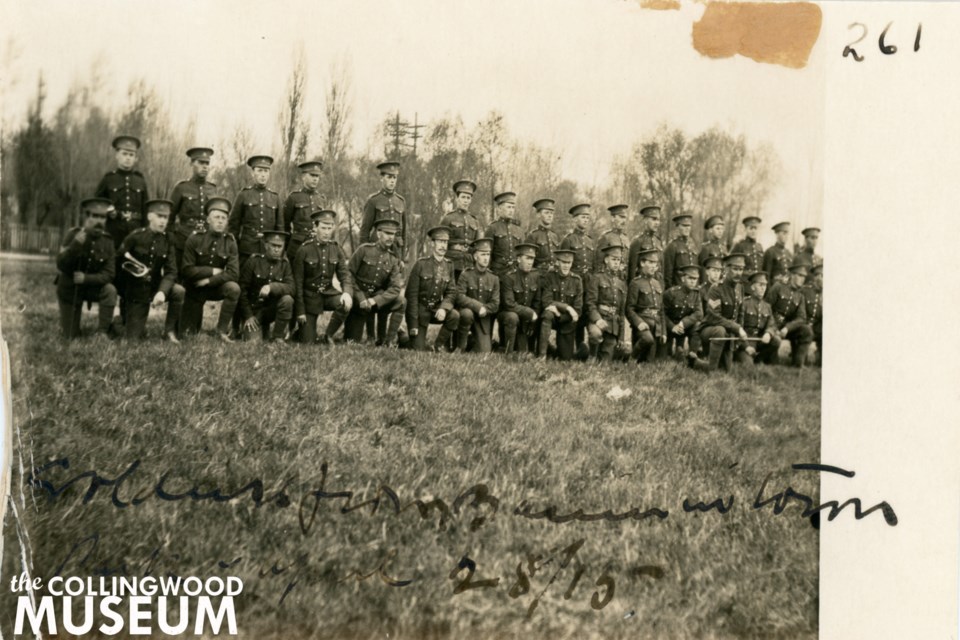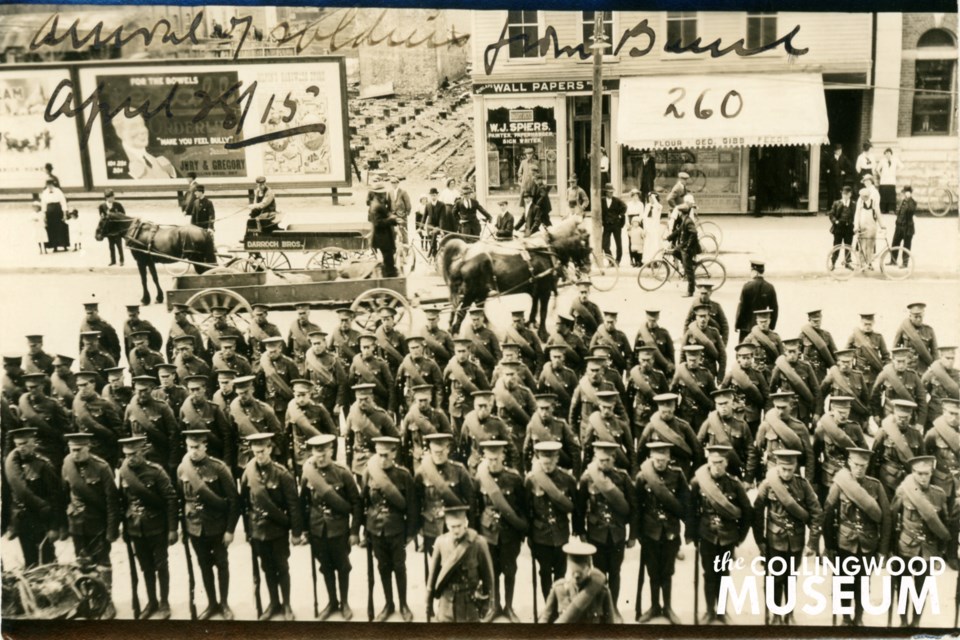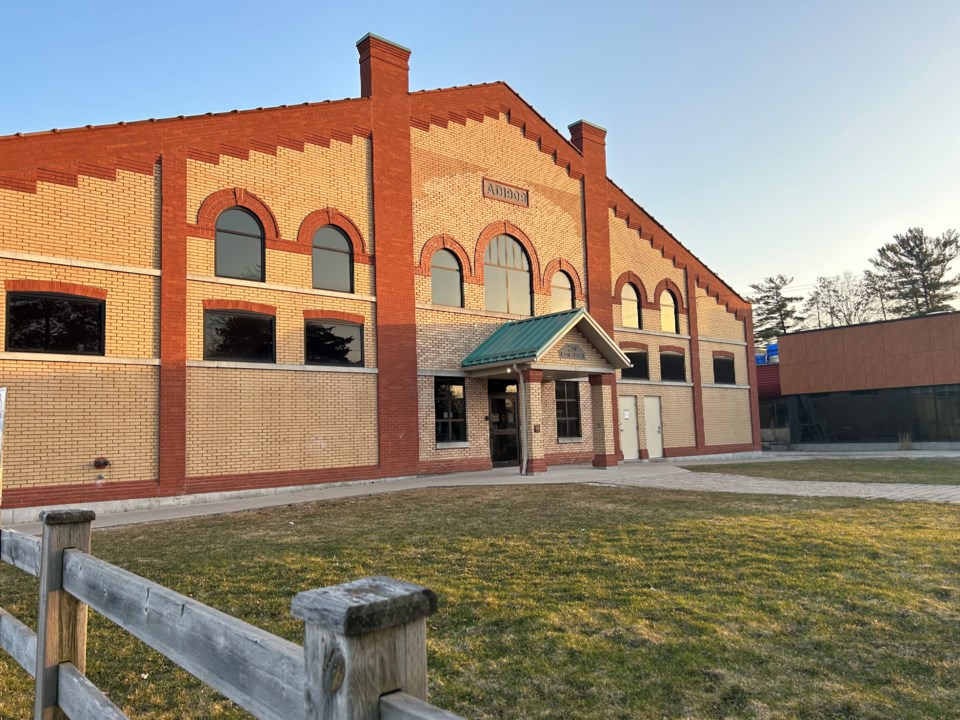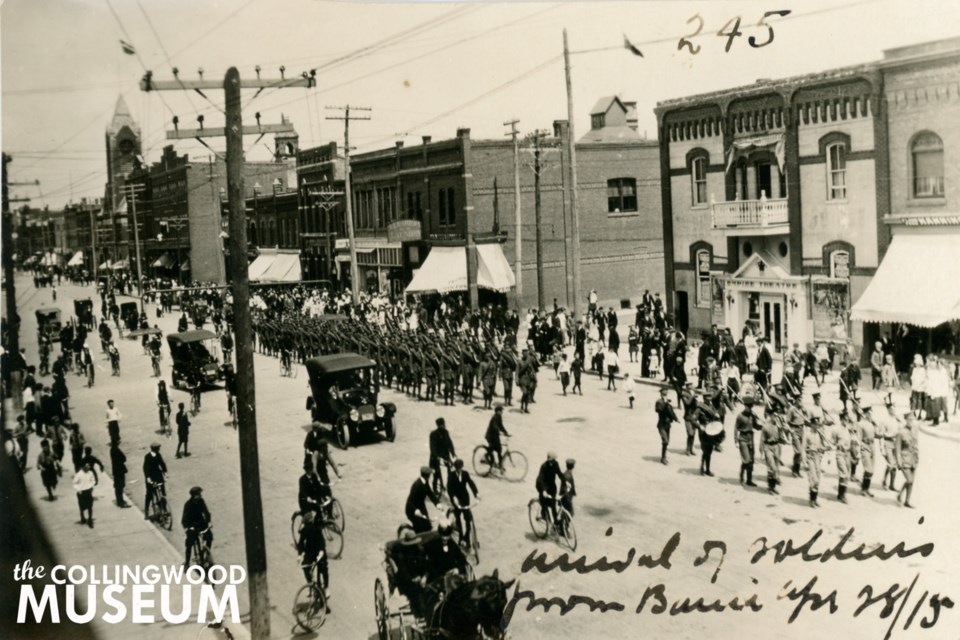This ongoing series showcases historic photos in the Collingwood Museum collection, with research and writing by Melissa Shaw, the museum supervisor.
For the residents of Collingwood, the arrival of soldiers in training during the First World War may have been a welcome distraction from the news (or lack of news) arriving from loved ones serving overseas.
On April 29, 1915, Collingwood welcomed the soldiers of the third contingent who arrived at the local train station from Barrie. A newspaper article preserved in a scrapbook at the Collingwood Museum describes the soldiers’ arrival and the subsequent events planned by the town:
“They arrived here by noon train and are now in camp at the exhibition park, the main building being used as a bunk house. This Thursday evening, in the Grand Opera House they will be formally welcomed by the citizens. Arrangements for this event have been effected by the regents, officers and members of the local chapters of the Daughters of the Empire, and a cordial invitation is extended to every citizen to be present. The proceedings are to take the form of a concert, and addresses of welcome will be made by a number of prominent citizens. At the close of the evening’s program an informal reception will be tendered by the members of the expeditionary force by the Daughters of the Empire of the Parish Hall.” (Collingwood Museum Collection, X974.965.1)

The scrapbook in which this article appears is one of three in a series compiled by Miss Frances A. Redmond during the First World War. Redmond served as vice-president of the Collingwood Museum’s predecessor, the Huron Institute, and regularly represented the Huron Institute as a delegate at Ontario Historical Society meetings.
In 1920, Redmond donated her third and final scrapbook to the Huron Institute’s collection. The importance of the donation is described in the Institute’s annual report for 1920.
“Yet another of the additions of the year is the third volume of the almost invaluable scrapbook of Collingwood and the War… This completes the work, which covers the activities of the men and women of Collingwood from August 1914, until August 21, 1919, when the soldiers were so joyously welcomed home. It was no small undertaking and represents five years of careful and close attention to events, which, to one who was so active in war activities, meant very great additional labour. As a record of the war work in a locality, it probably stands alone amongst the historical societies.”
Supplementing Redmond’s scrapbooks is at least seven photographs that document the arrival of the third contingent in Collingwood. In today’s featured photograph the soldiers parade south on Hurontario Street, between Simcoe and Ontario Streets. Other photographs show the soldiers in formation facing town hall, and at Exhibition Park, today’s Central Park.
News of the third contingent’s reception in Collingwood reached local soldiers serving overseas as newspapers were commonly sent by family and friends.

Collingwood soldier, Private Fred Goddard, shared his thoughts in a letter written home to a friend:
“I and all of us notice and were only talking about it the other day the fuss they are making with the Third Contingent. This alludes to the Home Guards. Some regiment – pretty safe at home I guess, and good soldiers you bet. We saw in a Collingwood paper which we got by chance that the Home Guard had a good time at the smoking concert which they have held pretty often this winter… I wonder if they gave us a thought while we were in the trenches looking for a smoke and couldn’t get them…”
Private Goddard’s letter, like many others, was shared with Collingwood’s newspapers for publication. Many of these, in addition to articles about local fundraising efforts and service updates for local soldiers, are preserved in Redmond’s scrapbooks.
Frederick Sydney Goddard enlisted with the 35th Regiment Simcoe Foresters in the first contingent of soldiers and was among the first recruits to leave Collingwood in 1914. He was injured on April 23, 1915, at the second battle of Ypres in Belgium. He arrived home to his wife and children in November 1915. At his request, no public demonstration was made at the train station when he arrived.
To learn more about Collingwood during the First World War, explore the Collingwood Museum’s First World War Virtual Walking Tour available at www.collingwood.ca/museum.
The interactive tour was launched on November 11, 2022, using Google Earth and Google Maps to showcase historic photographs and stories in the context of Collingwood in the present day.
If you have any stories to share about Collingwood during the First World War, please contact Collingwood Museum staff.




